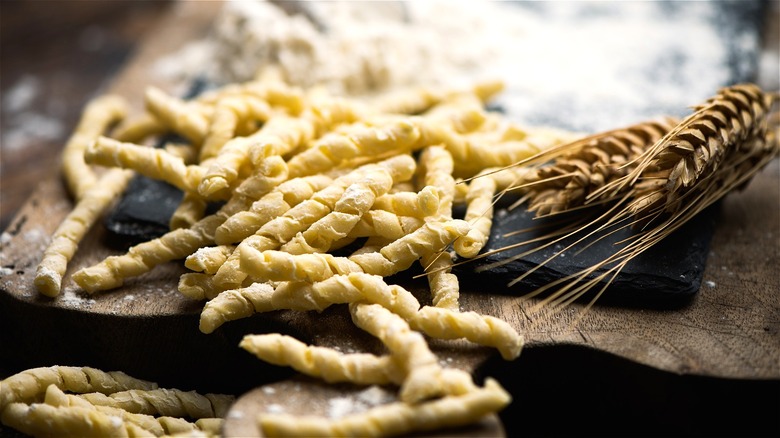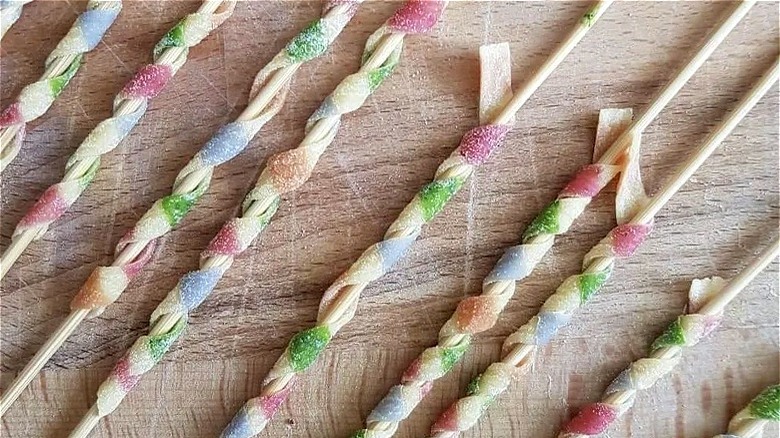All You Need Is A Chopstick To Make Spiral-Shaped Pasta Like A Pro
When attempting to handcraft a meal that's both delicious and reliable, homemade pasta might seem like a big undertaking. Maybe it's that recurring mental image of raw eggs sitting in a pile of flour, or the thought of having to purchase a special piece of kitchen equipment just to achieve that ideal specific shape and texture. However, you actually don't always need a pricey stainless steel pasta maker to make the same fun shapes you see neatly packaged in supermarkets.
Surprisingly, you only need the handle of a small wooden spoon to make homemade penne pasta, and the precision of your hands to make farfalle or bow-tie shapes. Upon consulting the ultimate guide to pasta shapes, you might be intrigued by the spiral pastas. After all, you need a twisted noodle to soak up all the rich complexity in your latest batch of cream cheese alfredo sauce. The good news is that to make these fun, springy noodles, you only need time, patience, and a trusty chopstick.
In using a common, uniform kitchen utensil, you're able to streamline your pasta-making process so all your noodles result in the same one-of-a-kind corkscrew shape. Here's how you can create homemade spiral-like noodles with just a chopstick — plus some useful tips you may want to save for future spiral pasta-making adventures with iconic varieties like busiate.
How a chopstick creates signature busiate pasta spirals
Before you start forming these unique spirals you need to make a dough, and luckily, homemade noodles only require a few common ingredients. Just be careful when tasting raw pasta dough because it's solely composed of raw eggs and flour, and could make you sick. However, since you have your heart set on busiate pasta, these signature spirals are typically made with only water and semolina flour. Once you've successfully hand-shaped a smooth ball of dough, it's time to start forming this supple mixture into classic busiate-style coils.
To do so, you first need to split a standard ball of dough into three or four sections so you have a smaller amount to work with when cutting out your noodles. Roll one section of dough into a log of sorts, then cut the log into individual pieces all the way across. Take one small piece of dough and roll it with your hands so the piece extends to roughly 4 inches and has the thickness of a wooden skewer.
Gently wind your thin piece of dough around a chopstick or skewer and then roll it on your counter to flatten the noodle before you carefully remove the formed coil from your chopstick. Apart from repeating the process until you have enough noodles, what are some things you should keep in mind when making busiate and other spiral pastas?
Neatly shaped pasta spirals take practice and patience
Now that you're successfully on your way to perfecting homemade busiate pasta, as with any new skill, you may encounter some roadblocks along the way. Making coiled pasta requires not only patience but a bit of trial and error to streamline the overall process.
When it comes to the shape of your pasta strands, pay close attention to the width and try to make them as uniform as possible for even cooking. If you're finding your pasta strands difficult to maneuver when coiling, start by using slightly shorter strands of dough. This will make the process of wrapping your dough around chopsticks more stable and will lead to less potential breakage. Also, make sure to flour your skewers or chopsticks — and your counter — with semolina flour before rolling out and forming your noodles.
If you find that in the process of releasing your twisted pieces of dough from chopsticks, the dough is still sticking, simply hold the noodle with one hand and carefully turn the chopstick with the other — this will help release the dough successfully. Now that you know spiraled busiate-style pasta is possible to create in your own kitchen with just a few chopsticks or skewers, you can start making impressive pasta dishes for your friends and family in no time.


